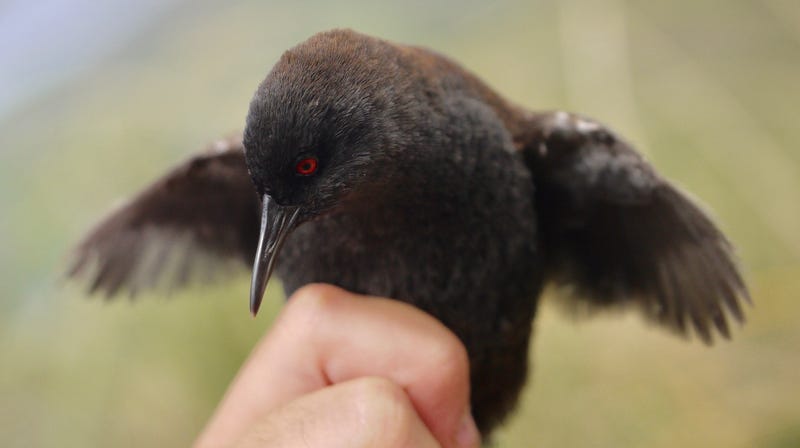 An Inaccessible Island RailPhoto: Martim Melo
An Inaccessible Island RailPhoto: Martim Melo
An island half the size of Manhattan in the south Atlantic Ocean is so isolated, it’s called Inaccessible Island. On that island, and only on that island, live nearly 6,000 puny featherballs called Inaccessible Island rails. But they can’t fly, and the island is only a few million years old. How did the birds get there?
A new analysis may have solved the mystery. The bird’s DNA reveals that it evolved relatively recently from some visitor to the island, and lost its ability to fly from the forces of natural selection.
“It’s quite spectacular that the word’s smallest living flightless birds ended up in one of the most remote places ever,” study author Martin Stervander, University of Oregon postdoctoral researcher, told Gizmodo. “It seems the birds arrived on the island, and since they faced little threat from predators, there wasn’t much point of flying.”
When scientists first described the bird in the 1920s, they knew immediately that they were looking at something strange. Inaccessible Island is 3,500 kilometers (2,175 miles) from South America and 2,800 kilometers (1,740 miles) from southern Africa. The bird doesn’t occupy either of two nearby islands located less than 20 miles away. They proposed, before the theory of plate tectonics existed, that the bird somehow walked to the island over some sort of sunken land bridge. They placed it in its own genus, Atlantisia. More recent research has proposed that the bird originated from rails in Africa.
A. Inaccessible Island relative to Africa and South America. B. The Inaccessible Island rail. C. The dot-winged crake. D. The black rail. E. The Galapagos crake.Graphic: Stervander et al (Molecular Phylogenetics and Evolution, 2018)
The scientists behind the new paper have analytical tools other than bird shapes and geography at their disposal. They captured a male Inaccessible Island rail in September 2011, sampled its blood, sequenced its DNA, and compared the results to data on other rails. They inferred that the rail’s ancestor was a South American bird that arrived on the island approximately 1.5 million years ago, and that it’s more likely a member of the Laterallus genus, which includes present-day birds like the dot-winged crake, the Galapagos crake, and the similar-looking black rail, according to the paper published in the journal Molecular Phylogenetics and Evolution.
It makes sense. Rails are notorious for flying wherever and settling in, with 53 existing or recently extinct species appearing only on islands, and 32 species losing some or all of their flight ability as a result. A population of the Inaccessible Island rail’s ancestors probably flew east into the Atlantic and ended up on the island—which was a sweet enough gig that they didn’t need to fly anymore.
“When the rail arrived at Inaccessible Island, they had all their food from walking around and there was nothing to escape from, there’s not much need for flying,” said Stervander. The bird’s only threats on Inaccessible Island are another bird species that sometimes eats eggs, and perhaps a few seabirds.
It’s unclear why the rail didn’t head over to the other two islands—perhaps a population tried and failed.
Stervander pointed out that there’s more research to be done. The dataset on the rails was incomplete, so perhaps more data will reveal that the bird really does belong to a separate genus.
And though the bird is living the good life, it’s still considered a vulnerable species. Flightless bird populations can easily collapse if humans bring invasive species with them, like cats or rats.
This paper solves perhaps the cutest mystery in the southern Atlantic Ocean. But if you plan on visiting the island (which is not an easy feat) make sure you’re not doing anything to harm the birds.
[Molecular Phylogenetics and Evolution]
Share This Story